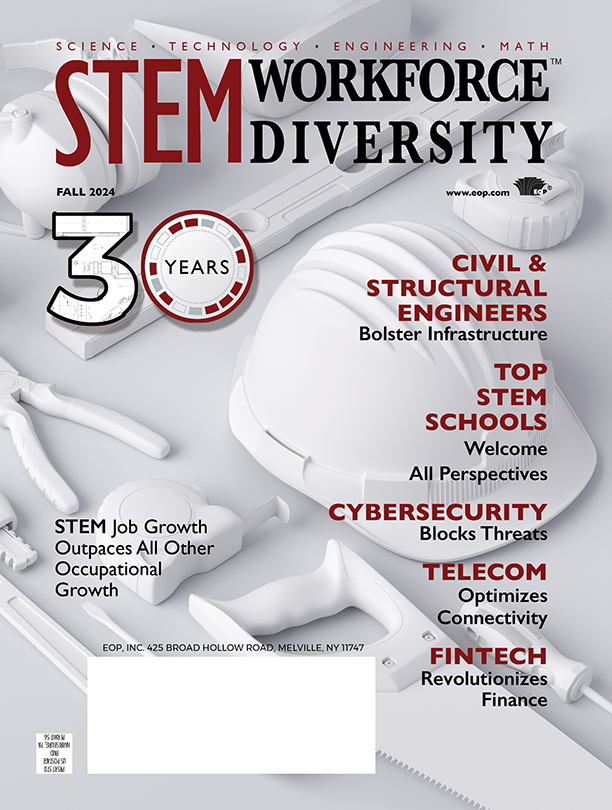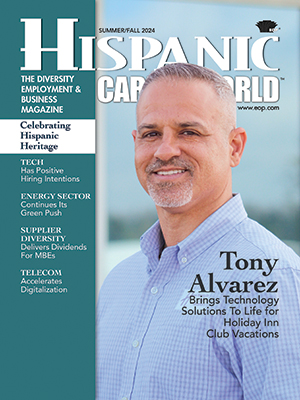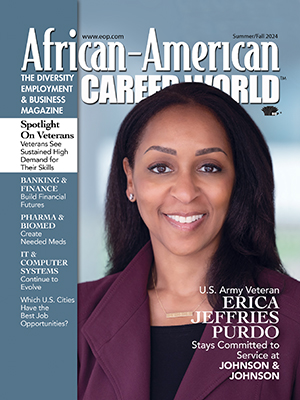By Rachel Sokol
Meet several professionals who are thriving in civil/construction engineering, building success for themselves as they help their companies bolster crucial infrastructure one brick at a time.
Brown Leads a Team at DPR Construction That Ensure Positive Project Progress
A young Kimberly Brown enjoyed helping her father build a deck. This act, along with encouragement from a family friend who was a general contractor, is why Brown immersed herself in construction courses – and internships – in high school and college.
“And it never got boring,” she shares.
Today Brown is a senior project manager at DPR Construction, a position she’s held for more than five years. She describes her job as “a lot of fun and very rewarding. I love the collaboration, and how every day brings new challenges, things to figure out and also work around.”
Brown and her team ensure they’re providing the proper materials as specified to go into a project, and assisting with writing contracts and pushing the schedule. “We’re a liaison to ensure client satisfaction,” she adds.
In addition, Brown’s team double-checks project progress. “That they’re actually building what we’re being requested to build, and ensuring that happens on time, and efficiently,” she elaborates.
As exciting as it can be, challenges understandably do arise in the world of construction. “It’s all about putting our heads together on how to conquer it,” according to Brown.
For example, her team was recently tasked with a major dig. “You don’t want to just put a shovel in the ground not knowing what’s in the dirt and finding the foundation underground is 30 to 40 feet deep,” she notes about that project.
Brown and her colleagues engaged in utility-locating and performed a process called “vac trucking” that sucks the dirt out to make sure nothing’s there where you’re digging. It really her team’s foundation work to be installed without any conflicts.
Another challenge Brown and her team must tackle is maintaining sustainability. “We’re frequently asked to track recyclable materials, and we know that up front, so we’re able to obtain different dumpsters to store various items for recycling,” explains Brown, who also underscores the push for ever more energy- and water-efficient materials to meet evolving specifications.
Brown’s noticing major moves toward virtual design in construction, too. “When I first started, we had a big paper plan, and I had a green pencil and marked up the drawings with it. Nowadays, things are a bit easier. We’re moving toward regularly having the building design virtually, or at least modeled virtually, to look for any clashes, or anything that could be obstacles, prior to even building it.”
Interested in a construction career and want to follow in Brown’s footsteps? She offers some insights and tips, including having knowledge of virtual and BIM design is “the way to go.”
Through the years, Brown’s has also seen an increase in the number of women in the field, which has been rewarding. “I think there’s a lot of career opportunity, which is a beautiful thing,” she adds.
According to Brown, a career in construction and civil engineering offers myriad opportunities. “You can move one in so many different directions. You can be in operations, you can do pre-construction, and you can end in development. There are so many different sectors, even in healthcare and advanced technology. So it’s very open, and it’s going to keep getting better!” she enthuses.
DPR Construction is headquartered in Redwood City, CA. Find career opportunities at dpr.com/company/careers. Connect on Facebook, X, Instagram, YouTube and LinkedIn.
Nakao Designs Sustainable Power Plants for Rosendin
A college mentor who happened to be a mechanical engineer and a previous job opportunity, inspired Carissa Nakao, PE to work as an electrical engineer within the construction industry. “I was introduced to Rosendin in Hawaii and helped procure some of their material for some of their local projects,” she recalls.
“After joining Rosendin full-time after graduating from the University of Hawaii at Manoa, I eventually transitioned to the renewables department and had the privilege of being able to learn how to design utility-scale solar projects.”
Today her official title is engineering team lead with Rosendin’s renewable energy group.
At Rosendin, Nakao explains that many of the company’s recent projects have seen photovoltaic (PV) module and equipment procurement issues. “Changing the PV module on a project can cause a chain reaction of changes affecting multiple different trades,” she explains.
“We’ve been working to get around these issues by building flexibility into our designs to better accommodate unpredictable procurement issues.”
She uses National Electric Code (NEC) in her work to help ensure her team’s designs meet the proper regulations and requirements. “The National Fire Protection Association (NFPA) has an online service that allows us to look at multiple different versions of the various codes. It’s important to be able to cross-reference different editions of the code.”
Working in the renewables world, she also frequently uses software like PVsyst to simulate the power-generating capacity of the company’s designs.
Nakao further underscores the importance of sustainability when her team’s designing utility-scale solar projects.
“We’re designing these plants to last and perform in the long run. Once in operation, our projects are designed to withstand the elements of the site conditions,” she elaborates, adding that environmental factors are also considered when designing and constructing a solar farm to ensure employees aren’t disturbing the local wildlife or protected species.
According to Nakao, Rosendin is always trying to innovate new solutions to value-engineer its designs. “There are constantly new products being introduced in the renewables market and new materials being used. Technology is ever-improving, and our designs are constantly evolving, and we’re always seeking new solutions to incorporate into our designs.”
In addition to keeping up with the latest tech and sustainable solutions, the construction field is heavily based on relationships and interacting with people. And that’s something that opens up opportunities. “Women especially shouldn’t be afraid of joining the construction industry as there are a wide range of careers that only require the willingness to learn and a positive attitude,” Nakao encourages.
Rosendin Electric is headquartered in San Jose, CA. Find career opportunities at rosendin.com/careers. Connect on Facebook, YouTube, X, LinkedIn, Instagram, Glassdoor and TikTok.
Olaso Is a Technical Innovator at Schindler
The late 1990s internet explosion tremendously impacted Samantha Olaso’s perception of technology’s role in daily life, which sparked her interest in STEM. Today she’s a research and development (R&D) technical assistant for Schindler Elevator Corporation.
What Olaso loves about her work now is “successfully transforming concepts into reality is the most beautiful part of engineering. It’s incredibly satisfying to see my work come to fruition in a concrete, practical way.”
Olaso’s work varies tremendously on any given day. “But I typically interface with internal partners outside our typical development process, handle anything requiring access and understanding across multiple domains, and whatever else is needed,” she explains.
She’s currently compiling evidence of code compliance, which involves reporting to the government on the company’s 2023 work, and handling logistics for its third-party testing.
Olaso’s department uses typically uses Creo/Windchill to be in alignment with their partners across the company’s global organization. Recently, Olaso had to figure out how to source and send one of Schindler’s elevators to Brazil for the first time. Thanks to her knack for problem-solving, she picked up some management skills along the way.
“At my previous job, we knew our manufacturing plant was packed well beyond the customer’s timeline,” she recalls. “I figured out how to repurpose enough existing material from canceled projects to make the schedule.”
A creative technical innovator and problem-solver, Olaso credits her successful resolution to this challenge and her overall job success to methodically searching for gaps in knowledge/understanding, “then finding creative ways to address them with existing processes.”
Her advice for future engineers is to remember that even if you’re not working directly on sustainability issues, “incorporating sustainability into design can prevent new issues from arising and reduce our negative environmental impact.”
As the world grows increasingly interconnected, she further points out, construction and technology grow increasingly interconnected, too. As a result, being able to adapt to change and challenges is key. “Adaptability is valuable for mitigating the uncertainty that accompanies rapid change,” she adds.
In addition, Olaso recommends keeping in mind the best design solutions “don’t happen in a vacuum. Tour factories, visit job sites, seek user feedback, and take every opportunity to better understand your work’s context.”
Schindler Elevator Corporation is headquartered is in Morristown, NJ. Find career opportunities at schindler.com/en/careers.html. Connect on LinkedIn, X, Instagram, YouTube, Facebook.
Torra-Bilal Focuses on Work Safety & Team Communication at ComEd
Ines Torra-Bilal, Ph.D., PE joined ComEd a little more than a year ago after earning her doctoral degree in structural engineering from the University of Illinois. She’s now a senior engineer who works on large civil engineering projects for transmission and substation facilities at ComEd, an Exelon company. She ensures the reliability and resiliency of ComEd’s power infrastructure, which spans more than 11,400 square miles.
To help support the fast-growing clean energy economy in Illinois, ComEd sometimes outsources large engineering projects, according to Torra-Bilal. One day, while performing a quality assurance walk-down of a contractor project, she found the structure didn’t meet ComEd safety guidelines.
Bringing attention to this as the only woman in the room with an external company when diversity, equity and inclusion (DEI) are core ComEd values wasn’t easy for Torra-Bilal. “Here I had to learn how to communicate effectively and confidently with leadership and the contractor teams to fix the problem. In the end, I was happy I discovered the issue, and reported it for the improvement and overall safety of our work,” she shares.
A recent project on which Torra-Bilal worked focused on a structure with good bones, but that wasn’t meeting the company’s new standards. The dilemma was either to leave alone an outdated, yet functioning, structure or spend budget money on replacing it.
“After analyzing the problem from all angles, I decided to replace it,” explains Torra-Bilal. “Because this structure didn’t fit nicely into a category, this project had me work outside of my normal scope and led me to learn about risk management.”
At work, Torra-Bilal mainly uses RISA 2D and 3D, a software that helps analyze structures like a foundation or steel pole and the load they can resist. “To run calculations, we use Mathcad, which is an advanced form of Excel where you can write your formulas and see all of your calculations in a roomier setting. We use these tools and other advancing technology to get jobs done more quickly and accurately, making managing time and budgets easier.”
Today, contends Torra-Bilal, the future of construction is bright due to on-going innovation and advancing technology.
“Everything in construction used to be done by hand, including designs,” she elaborates. “Today we have access to more resources and powerful, user-friendly software to get jobs done more efficiently. Combining these tools with a heightened awareness of sustainability across the industry is leading us to produce high-quality, long-lasting structures.”
Her key advice for aspiring construction engineers is to think outside the box. “In school, lessons are very structured, but once you’re in the workforce, you’ll realize that problems won’t be so straightforward,” she points out.
Torra-Bilal also advises to not be afraid to ask for help. “Some things aren’t taught in school, so you’ll need to be able to communicate concerns or when you need help. Teamwork is important in this complex field,” she concludes.
ComEd is headquartered in Chicago, IL. Find career opportunities at careers.comed.com/search/jobs. Connect on Facebook, YouTube, X, Instagram, LinkedIn, Nextdoor and Pinterest.
Verdi Oversees Chevron’s Genesis EOL Project
Mariana Verdi, a facilities engineer who’s been with Chevron since 2012, enjoys working on projects that make a difference in local communities, and for the energy industry. “I like finding creative solutions to some pretty unique challenges and, as an extroverted Latina, I enjoy the teams I get to work with to do so,” she shares.
Verdi’s latest project involves Genesis, the company’s oldest deepwater production facility in the U.S. Gulf of Mexico. There she’s the end-of-line (EOL) project manager. And, as such, for the past four years, she’s overseen the decommission of Genesis and now the facility’s transition next year to the Louisiana Rigs to Reefs program.
“On this project, I’ve led a cross-functional team through ceasing production, flushing all equipment, plugging the well and removing risers,” she explains. “This year, we’ll be scrapping the topsides facility and towing the floating structure to be converted to an artificial reef.”
According to Verdi, this project is unique in that it’s the first of its kind for Chevron: the first deepwater floating platform to be designed, fabricated, installed, produced and decommissioned all by Chevron.
“When I first joined the Genesis operations team in 2017, I was presented with an issue that needed to be addressed immediately,” recalls Verdi, who’s leaned on her and her team’s problem-solving ability heavily during this project. “We had integrity issues with the flare tip at the end of our flare boom – the maintenance task was problematic because the tip wasn’t within reach of our platform cranes, and too heavy for someone to manually handle.”
To resolve this, Verdi’s team partnered with process engineers to confirm it could safely remove only the flare tip with minimal impact to operations. Fortunately, there was a heavy-lift vessel (HLV) working nearby.
“The team partnered with Chevron structural engineers and a third-party, who specializes in lifting and rigging techniques, to align schedules to safely remove, repair, and reassemble the flare tip,” she details. “It was a unique situation, and I was very proud with how it all came together.”
As Verdi has found pursuing a career in engineering, architecture or construction is both a rewarding and humbling journey. “You’re literally designing and building the infrastructure that powers the world forward.”
Her parting advice is to “stay humble as you enjoy the journey and embrace challenges because every challenge can be turned into an opportunity.”
Chevron is headquartered in San Ramon, CA. Job opportunities are found at: careers.chevron.com. Connect on Facebook, X, LinkedIn, YouTube, TikTok and Instagram.
Bolstering Infrastructure & Building Success
Civil and construction engineers play important roles in bolstering infrastructure and building success. In fact, the American Society of Civil Engineers (ASCE) underscores how infrastructure investment in the U.S. is trending upward with state and local governments’ commitment to improving it while the U.S. Bureau of Labor Statistics (BLS) notes how this means increased employment and promotion opportunities for civil and construction engineers.
It’s clear that this is one sector and engineering discipline seeing steady growth as federal money trickles down to state and local governments for projects, both large and small. And construction and civil engineers are trailblazers and visionaries who are building a better tomorrow.
According to the U.S. Bureau of Labor Statistics (BLS) engineers, as cited by Michigan Tech’s official blog, the engineering field projects employment growth of 6% through 2030. That means nearly 146,000 new engineering jobs will be created during the next decade, including career opportunities within the construction field.
Captions & Callouts:
Kimberly Brown is a senior project manager at DPR Construction.
“You can move one in so many different directions. You can be in operations, you can do pre-construction, and you can end in development. There are so many different sectors, even in healthcare and advanced technology. So [construction and civil engineering] is very open, and it’s going to keep getting better!”
Carissa Nakao, PE is engineering team lead with Rosendin’s renewable energy group.
“Women especially shouldn’t be afraid of joining the construction industry as there are a wide range of careers that only require the willingness to learn and a positive attitude.”
Samantha Olaso is a research and development (R&D) technical assistant for Schindler Elevator Corporation.
“Adaptability is valuable for mitigating the uncertainty that accompanies rapid change.”
Ines Torra-Bilal, Ph.D., PE is a senior engineer who works on large civil engineering projects for transmission and substation facilities at ComEd, an Exelon company.
“Today, we have access to more resources and powerful, user-friendly software to get jobs done more efficiently. Combining these tools with a heightened awareness of sustainability across the industry is leading us to produce high-quality, long-lasting structures.”
Mariana Verdi, a facilities engineer at Chevron, is the end of line (EOL) project manager for Genesis, the company’s oldest deepwater production facility in the U.S. Gulf of Mexico for which she’s overseen the facility’s decommission for the past four years and its transition next year to the Louisiana Rigs to Reefs program.
“Stay humble as you enjoy the journey and embrace challenges because every challenge can be turned into an opportunity.”







